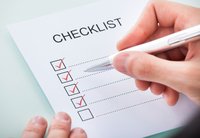Preflight Checklist Can Save Time Save Money and Better Serve Customers
Posted by Andrew Greess on Jun 2, 2015
Every pilot goes through a pre-flight checklist before flying his plane. The checklist helps a pilot find problems on the ground, where they can be more easily and safely resolved. Professional spray technicians should do the same.
Before getting into the truck and heading to the first stop, spend a few minutes checking equipment. This saves time and money, as well as prevents downtime that impacts productivity and profitability, and hinders timely service to customers.
If you’re going to have an equipment problem, you’re better off having the problem at the office (or at home if the vehicle is taken home), rather than in the field. At the office, you’re better prepared to make a repair, clean up a chemical spill, find a replacement part, substitute a piece of equipment, or make a management decision about how best to proceed. Out in the field, repairs are more difficult, time consuming and expensive, and the impact of a chemical spill can be disastrous.
Create a custom pre-flight checklist based on the company’s truck and equipment.
Following are ideas to get you started on a checklist:

Manual equipment (hand sprayers and backpacks)
- Is there water under the sprayer?
- Is there any visible damage?
- Pump up the sprayer.
- Does the sprayer hold pressure?
- Are there any leaks?
- Does the sprayer spray properly?
- Does the sprayer shut off properly?
- Is the spray pattern intact?
Power equipment Check the filter. Clean it, if necessary. Check the O-ring for swelling, which can prevent an airtight seal. Pull 20 to 30 feet of hose off your reel and inspect for wear. Most hose leaks occur in this area.
Gas rig:
- Check to ensure engine has gas and oil.
- Inspect pull cord for wear.
- Inspect belts for wear.
- Ensure there’s water in the tank, so the pump isn’t damaged by being run dry.
- Start the rig, and let it build pressure.
- Check the pressure gauge for proper operating range.
- Listen to pump and motor for abnormal noises.
- Inspect all hoses.
- Check pump
- Check all fittings and clamps for leaks.
- Check tank output fitting for leak.
- Check hose reel swivel for leaks.
- Check spray gun for leaks.
- Use the gun to spray material back into tank. Observe the system for proper operation.
- Rewind the hose on the reel to test the reel for proper operation.
- Test electrical components – such as the pump ans rewind hose reel – for proper operation.
Other equipment and supplies
- Ensure there’s enough extra gas for the day’s stops.
- Ensure there’s enough chemicals for the day’s stops.
- Ensure label/MSDS for the products is on the truck.
- Ensure there’s enough supplies for the day’s stops
- Ensure proper PPE (personal protective equipment) is on the truck.
- Ensure there’s spill-control supplies on the truck.
- Ensure the required equipment is on the truck.
Add items to the checklist that are appropriate for your company. Technicians should report any problems or exceptions they find to their supervisor. Supervisors should have a vehicle inspection checklist that includes all the items on the technician checklist plus additional items critical to the company’s success.
A few minutes in the morning spent checking equipment, will be the most productive the entire day.
When you need professional spray equipment, parts and supplies, pest control and landscape companies, look to Qspray.com for everything you need to be your trusted resource.

